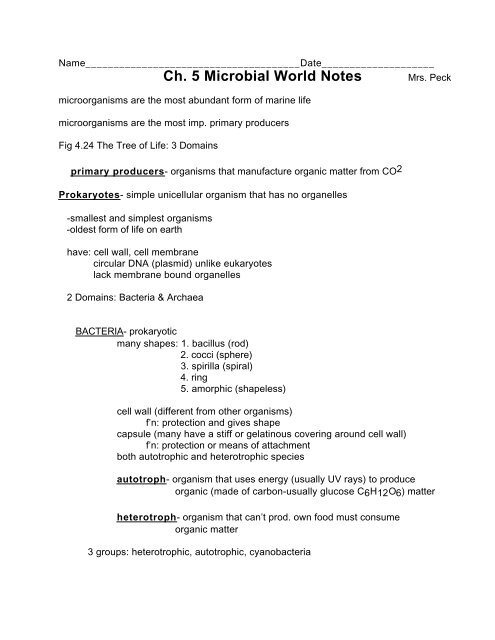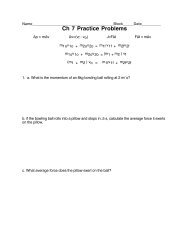Ch. 5 Microbial World Notes
Ch. 5 Microbial World Notes
Ch. 5 Microbial World Notes
- No tags were found...
Create successful ePaper yourself
Turn your PDF publications into a flip-book with our unique Google optimized e-Paper software.
3PROKARYOTESBACTERIACYANOBACTERIAmost microscopic; some form long filaments, strands or thick mats (visible to eye)stromatolites- massive calcareous mounds formed by cyanobacteriasome of the oldest fossils: 3 billions yrs. oldstill being made in tropical seas fig. 5.3calcareous- made of calcium carbonate (CaCO3)widely distributed in marine env. bcs tolerant of wide ranges of salinity and temp.endolithic- cyanobacteria (blue-green algae) tht burrow into calcareous rocks &coral skeletonssome so-called red tides are actually blooms of cyanobacteria high in phycoerythrinnitrogen fixation-conversion of gaseous nitrogen (N2) into compounds tht canbe used by autotrophssome are epiphytes and endophytes(many cyanobacteria are nitrogen fixers)epiphytes-a photosynthetic org. tht lives on algae or plants (seaweeds &seagrasses)endophytes- a photosynthetic org. tht lives w/in cells or tissues of algae or plantssymbiotic- organisms that live on or in another organism and one is benefited3 types: parasitic- a symbiotic relationship in wh/ one org. is harmed(host)by the parasite-disease and/or deathmutualism- a symbiotic relationship in wh/ both orgs are benefitedcommensalism- a symbiotic relationship in wh/ one org gets shelterfood, or oth. benefits w/o affection the other (host)algae lvg w/in orgs prod. bioluminescencechemosynthetic bacteria live w/in orgs. near hydrothermal ventproducing organic matter from CO2 and H2Sprod. neurotoxins that end up w/in marine orgs used for defense
EUKARYOTESPROTOZOANSzooplankton6FORAMINIFERANS (forams) fig. 5.10marine protozoan mostly bottom dwellingtest-shell made of calcium carbonate (CaCO3)imp: limestone & chalk beds from foram sediment (white cliffs of Dover, Eng.)red form shell’s (skeletons) responsible for pink beaches of Bahamaspseudopodia-thin or blunt extension of cytoplasmused for locomotion or to obtain foodforaminiferan ooze- sediment tht consists mostly of calcareous shells offoraminiferansRADIOLARIANS fig. 5.11marine planktonic org open water of oceanuses pseudopodia to capture foodornamental silica shell (made of glass) with spinesradiolarian ooze- biogeneous sediment that consists mostly of silica shells ofradiolarians found on ocean bottomsCILIATESmarine ciliates found creeping over seaweeds, in bottom sediments, gills of clams,skin of fish, intestines of sea urchinsEUKARYOTESFUNGI- KINGDOM FUNGImostly multicellular (except molds and yeasts)500 marine speciesheterotrophs: lack chloroplasts & chlorophylldecomposers:IMP:1. most imp. decomposer of mangroves and help recycle nutrients in mangroveforests2. some parasites of seagrasses or bore into mollusc shells3. parasitic cause diseases in seaweeds, sponges, shellfish, and fish (economicloss)4. source of antibiotics used in medicine5. form lichens- org. that results from the symbiosis of a fungus & autotrophsuch as green algaemutualism:fungus gets nutrients for algae and algaephotosynthesize for fungusfew marine lichens: form thick,dark-brown or black patches in the wavesplashedzone of rocky shores (esp. N Atlantic shores)
















